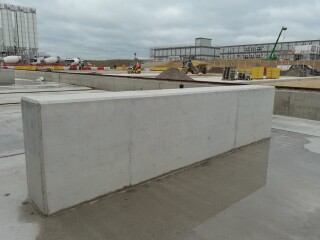The concrete has a carbon footprint that equates to a 62% reduction in CO2e per cubic metre of concrete compared to standard CEM I concrete (according to BSI PAS2050 calculations), yet meeting the same specification in the same raw materials.
The material has been used on a slab and a wall of a building in the site compound of HS2 contractor Align in Hertfordshire. This building houses the pre-casting of bridge sections for theColne Valley Viaduct.
When used in concrete, ground granulated blast furnace needs to be combined with an activator – typically Portland cement CEM I but alkali activation is also used. According to the Cementitious Slag Makers Association, a typical combination is 50% GGBS with 50% CEM I, but percentages of GGBS anywhere between 20% and 80% are commonly used.
The mixes, designed to Align concrete specification, exceeded expectations in both fresh and hardened properties, and showed that the new concrete can be produced in normal concrete plants and placed via mixer truck and by skip with tremie pipe.
This has demonstrated the potential to use more than 90% GGBS content to further reduce carbon emissions while still producing a quality finish and allowing normal construction and demoulding times.
With all aspects of concrete production and supply and no carbon off-setting applied, the material delivers an actual footprint of 133kg/m3 CO2e representing a saving of 220 tonnes CO2e for every 1,000 cubic metres produced, Tarmac said.

Robert Gossling, head of commercial engineering solutions at Tarmac, said: “Against the backdrop of the climate emergency, this project underlines the clear benefits which can be unlocked when clients and contractors collaborate, in this case engaging to help understand and accelerate the adoption of this new low carbon concrete solution.
“Together we’ve shown the material is fit for purpose in slabs and walls, with good repeatability and works with standard production and construction methods. This product is a great step along the UK concrete and cement industry’s net zero routemap, and the demonstration will help accelerate adoption of this new concrete.”
Align project director Daniel Altier said: “It is a strategic imperative for Align, reflecting the priorities of our JV partners and in line with HS2 commitments to reduce carbon emissions by 50% and look for opportunities to improve our carbon footprint. The early results of this trial are very encouraging and highlight the benefits to be gained through close collaboration with our supply chain partners.”
Tarmac and Align plan to expand the trial to other areas of the C1 project.
Tarmac supplies concrete for the construction of Central 1 section of HS2 Phase One that is being delivered by Align. This includes a 21.6km section of high-speed rail infrastructure incorporating a 3.4km viaduct across the Colne Valley, a 16km twin-bored tunnel, and five vent shafts.
Got a story? Email news@theconstructionindex.co.uk



